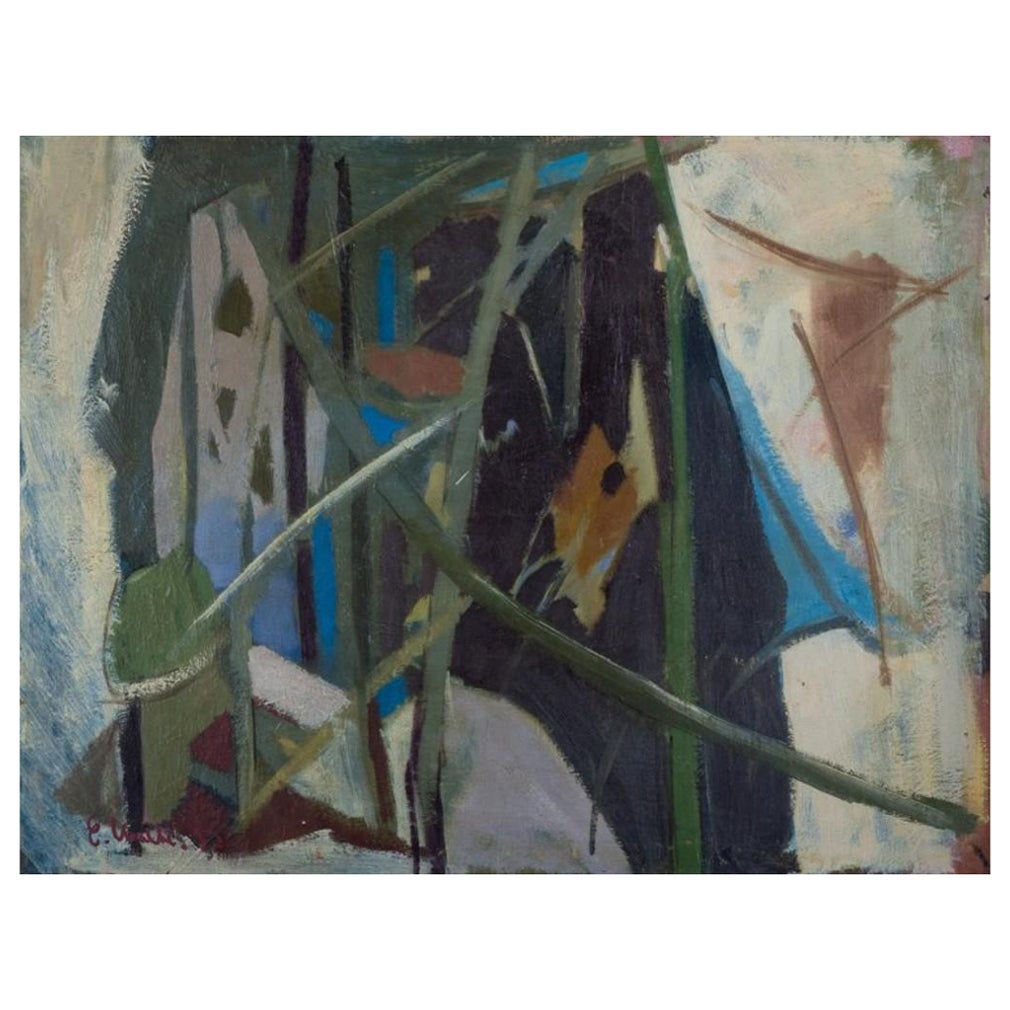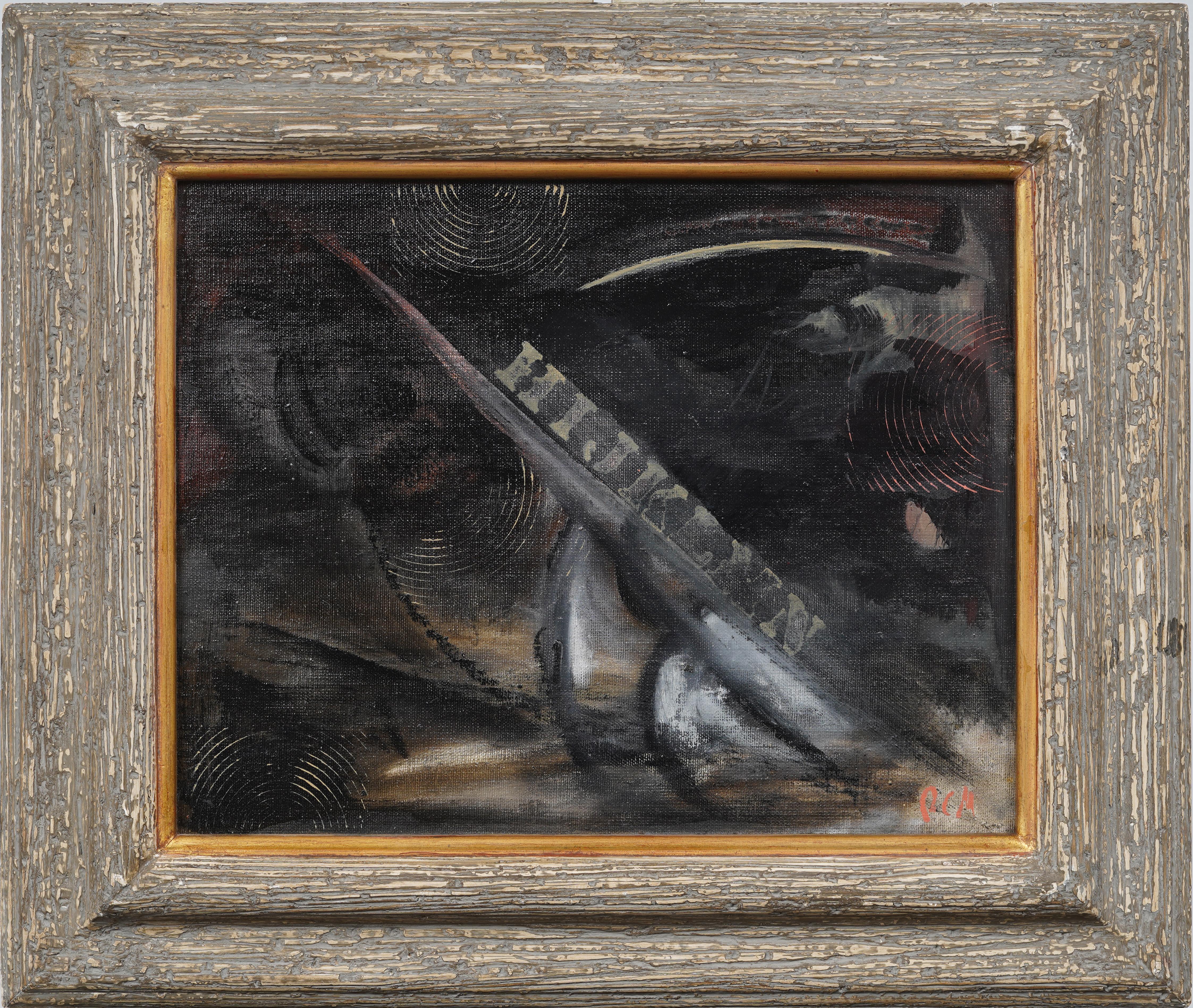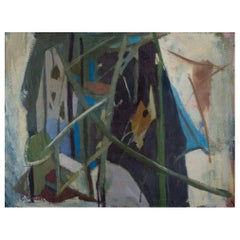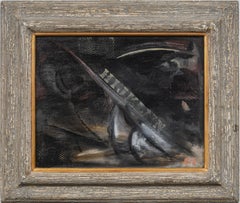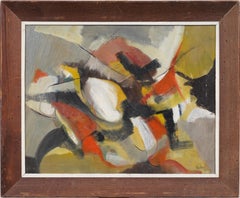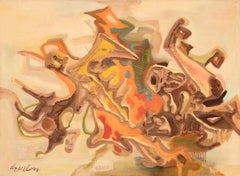Items Similar to Scottish 1949 Abstract - Interieur Forme Blanche - CoBrA art oil painting
Want more images or videos?
Request additional images or videos from the seller
1 of 16
William GearScottish 1949 Abstract - Interieur Forme Blanche - CoBrA art oil painting1949
1949
$26,393.35
$32,991.6920% Off
£19,200
£24,00020% Off
€22,476.76
€28,095.9620% Off
CA$36,862.28
CA$46,077.8520% Off
A$39,978.01
A$49,972.5220% Off
CHF 20,997.97
CHF 26,247.4620% Off
MX$485,600.75
MX$607,000.9320% Off
NOK 262,756.39
NOK 328,445.4820% Off
SEK 247,399.81
SEK 309,249.7620% Off
DKK 167,876.11
DKK 209,845.1420% Off
About the Item
This stunning Scottish Abstract oil painting is by much noted artist William Gear. It was painted in 1949, not long after Gear de mobbed in 1947, moved to Paris and established a one room studio at 13 Quai des Grands Augustins, hence the title Interieur, Forme Blanche. At the same time, Gear was introduced to CoBrA, allowing him to exhibit in important early CoBrA shows in Copenhagen and in Amsterdam in 1949. The same year saw an exhibition at the Betty Parsons Gallery in New York, alongside Jackson Pollock. Gear remained in Paris until the early fifties. This bold abstract mixes blocks of solid colour with more geometric lines and is an excellent and important example of his period in Paris.
Signed and dated '49 lower left.
Provenance: Private London collection.
Condition. Oil on canvas, 24 inches by 20 inches and in good condition.
Frame. Housed in a wooded white painted frame, 34 inches by 30 inches and in good condition.
Few British painters have played an active role in the modern abstract movement of post-war Europe. William Gear was the most passionate and committed exception. He continued the tradition of the Edinburgh-Paris axis established by J.D. Fergusson, Samuel Peploe and others, spending vital years between 1947 and 1950 living and working in Paris. Significantly, in recent years, he received the greatest acclaim in France, Germany and the Netherlands. He was born in 1915 in Methil, Fife, into a mining family; the particular landscape of "pitheads, the sea, rocks, castles, trees, storms and poverty" marked his earliest identity with a place and probably remained the most influential to his art. Years later he recalled as a schoolboy visiting the local art gallery in Kirkcaldy and seeing 12 colourful still-lifes by Peploe. Art-history lessons during student years at Edinburgh College of Art, in particular Byzantine classes under David Talbot Rice, also influenced his concern for structure. This had as much to do with the formal language of painting as sheer delight in the medium itself. Gear never missed an opportunity to show people the merits of a well-constructed painting. On a travelling scholarship in 1937, he chose to study with Fernand Leger, described by Gear as "a keystone for me, seldom abstract, rather a degree of abstraction". The Second World War interrupted these formative years and, by 1940, Gear had joined the Royal Corps of Signals. Dispatched to the Middle East, he still had the discipline to paint - mostly works on paper of damaged landscapes - with exhibitions in Jerusalem, Tel Aviv, Cairo as well as Siena and Florence. His naturally robust and tenacious temperament was profoundly affected by visiting Bergen-Belsen, and this certainly influenced the later experiments with the black armature. As the British officer in Celle, working for the Monuments, Fine Arts and Archives Section of the Control Commission, he focused on securing the safety of the Berlin Art Collection in Schloss Celle, and organised an important series of modern art exhibitions, including the rejected work of Karl Otto Gotz. Only a few weeks before his death, this service to "democratic art and artistic freedom" was recognised in Hanover by a unique Leporello Award, appropriately instigated by fellow artists and presented by the Lower Saxony government. Demobbed in 1947, Gear headed for Paris, where he established a one-room studio at 13 Quai des Grands Augustins. This exciting period saw him gravitating towards what he called "the freer, dramatic approach of abstraction lyrique" rather then "the dogmatic hard-edged school of Mondrian and De Stijl". Within a year there were exhibitions at two of the pioneering salons and a first one-man show at the Galerie Arc en Ciel. At the same time inclusion in Cobra shows in Amsterdam and Copenhagen in 1949, alongside Constant, Corneille and Appel, underpinned his affiliation to a reinvigorated form of abstract expressionism. He worked at the time in the fluid medium of opaque water-colour, usually on card with pockets of intense colour on a white or neutral ground. While some pieces were purely abstract, others carried their own suggestion of landscape, or even a form of Celtic figuration. The same year saw an exhibition at the Betty Parsons Gallery in New York, alongside Jackson Pollock. The impact of American abstract expressionism however remained a sore subject, which in conversation was usually dismissed with a curt reminder of what he and others were already painting in Europe. The decision to return to England in 1950 was both personal and practical. Recently married to Charlotte Chertok, and with a baby, he had already secured in 1948 the first of a series of London exhibitions with the Gimpel Fils Gallery. The atmosphere surrounding the Festival of Britain also appeared to offer fresh opportunities. Notoriously, Gear was awarded one of the Festival of Britain Purchase Prizes for Autumn Landscape, a large oil on canvas which took six difficult months to complete. The event produced written questions and answers in the House of Commons and a tirade of abuse from the national press, not to mention a topic for debate on the radio programme Any Questions. While the episode made him a household name, the longer-term effects were, arguably, more detrimental. He chose not to live in London or join fellow abstract artists in St Ives, preferring the independence of a village in Kent between 1953 and 1958. This period saw the continued development of large landscape structures, as well as "side-roads" into sculptural subjects and minimalist colour paintings, which openly acknowledged the influence of Nicolas de Stael. These works have still to be properly exhibited. Mau-Mau (1953), for example, painted for the Contemporary Art Society but at the last minute withdrawn from display at the Tate Gallery, has its first London showing in the current golden jubilee exhibition at the Redfern Gallery. Gear was out of critical favour for most of the 1960s and 1970s. He exhibited more irregularly, despite returning to the use of dark structures broken by selected movements and light-inflected primary colours. While contemporaries questioned his move to Eastbourne as Curator of the Towner Art Gallery (1958-64), Gear's response was to take on the Purchase Committee. He changed the local authority's collection policy from Victorian and local views to securing the foundation of a major collection of post-war British art. His move to Birmingham came with the appointment as Head of the Faculty of Fine Art, Birmingham College of Art, in 1964, a post held until retirement in 1975, by which time he had become increasingly un- interested in the growing bureaucracy surrounding art education. His support and encouragement to artists living in Birmingham however continued with the purchases made for Birmingham Museums and Art Gallery on behalf of the Friends organisation (1987-94) as well as for his own personal collection. Most recently he instigated the idea of a gallery of modern art in Birmingham. Fortunately, the last 15 years have also gone some way to reverse the years of neglect. Gear and Stephen Gilbert (also Scottish) were the only British artists included in the major Cobra 1948-51 exhibition at the Musee d'Art Moderne, Paris, in 1982. The Cobra enthusiast Karel van Stuijvenberg has been a prominent patron and, in 1995, Gear took delight in attending the opening of the Cobra Museum of Modern Art in Amstelveen, near Amsterdam. He was equally proud of his long overdue election to the Royal Academy in 1995, and in the last years relished working with the fluidity and strong colours of oil stick. Tessa Sidey. Exhibited and held by worldwide galleries including The Tate.
- Creator:William Gear (1915-1997, Scottish)
- Creation Year:1949
- Dimensions:Height: 30 in (76.2 cm)Width: 34 in (86.36 cm)Depth: 2 in (5.08 cm)
- Medium:
- Movement & Style:
- Period:
- Condition:
- Gallery Location:Hagley, GB
- Reference Number:1stDibs: LU853113312242
About the Seller
5.0
Platinum Seller
Premium sellers with a 4.7+ rating and 24-hour response times
1stDibs seller since 2018
463 sales on 1stDibs
Typical response time: <1 hour
- ShippingRetrieving quote...Shipping from: Hagley, United Kingdom
- Return Policy
Authenticity Guarantee
In the unlikely event there’s an issue with an item’s authenticity, contact us within 1 year for a full refund. DetailsMoney-Back Guarantee
If your item is not as described, is damaged in transit, or does not arrive, contact us within 7 days for a full refund. Details24-Hour Cancellation
You have a 24-hour grace period in which to reconsider your purchase, with no questions asked.Vetted Professional Sellers
Our world-class sellers must adhere to strict standards for service and quality, maintaining the integrity of our listings.Price-Match Guarantee
If you find that a seller listed the same item for a lower price elsewhere, we’ll match it.Trusted Global Delivery
Our best-in-class carrier network provides specialized shipping options worldwide, including custom delivery.More From This Seller
View AllAbstract - Scottish 1950's Abstract art oil painting
By Alexander McNeish
Located in Hagley, England
This superb Scottish Abstract oil painting is by noted sixties Edinburgh artist Alexander McNeish. An early work, painted circa 1957 when McNeish was just 25 years old, it demonstrat...
Category
1950s Abstract Abstract Paintings
Materials
Oil
$6,048 Sale Price
20% Off
Fifties Abstract - British 1954 abstract art oil painting Slade School artist
Located in Hagley, England
This superb British 1950's abstract oil on board painting is by noted Slade School trained contemporary artist Leo Davy. Davy was born in Yorkshire but settled in Cornwall in 1968 an...
Category
1950s Abstract Abstract Paintings
Materials
Oil
$7,698 Sale Price
20% Off
Scottish Abstract - Exhibited 1965 Abstract Expressionist art oil painting
Located in Hagley, England
This very striking exhibited Scottish Abstract oil painting is by influential Scottish artist Jack Knox. Painted in 1964, it is a vivid mix of autumnal colours, textures and brushwork that work perfectly. A brilliant example of his work from the early sixties and which was exhibited at the Royal Scottish Academy in 1965.
Titled and dated 21.2.64 lower right.
Provenance. Exhibited Royal Scottish Academy, Exhibition 1965, Edinburgh.
Condition. Oil on canvas, 51 inches by 36 inches unframed and in good condition.
Housed in a gilt sixties surround frame, 53 inches by 38 inches framed and in good condition.
Jack Knox RSA (1936-2015) was one of the most influential artists to work in Scotland in the second half of the twentieth century. Born John Knox to a family of tailors in Kirkintilloch, Knox studied at the Glasgow School of Art (1953-57) where his drawings were noted for their mature draughtsmanship. After graduating, Knox went to Paris to attend the atelier of Cubist artist, André L’Hȏte. During his time in Europe Knox digested the various art movements of the moment, including Surrealism, Tachisme, Colour Field and Pop Art. Visiting the great museums, he was particularly interested in Analytic Cubism and Georges Braque’s intimation, rather than description, of object. He also went to Brussels to visit the first major show of American Abstract Expressionism in Europe. He returned to Scotland eager to establish his own style, drawing on everything he had seen in Europe. In 1960 the Glasgow Herald presented an exhibition during the Edinburgh Festival of young artists from the west of Scotland. Knox was selected to show alongside George Devlin, Carole Gibbons, Anda Patterson, Douglas Abercrombie and Duncan...
Category
1960s Abstract Abstract Paintings
Materials
Oil
$15,396 Sale Price
20% Off
Spring Passage - Scottish art Abstract Expressionist oil painting Cobra Paris
By William Gear
Located in Hagley, England
This stunning Scottish Abstract Expressionist oil painting is by noted Scottish artist William Gear. Painted in 1950 it is an early and significant painting which dates to the early ...
Category
1950s Abstract Expressionist Abstract Paintings
Materials
Oil
$30,792 Sale Price
20% Off
Lonistum 1961 - Canadian British Abstract art oil painting
By William John Bertram Newcombe
Located in Hagley, England
An original large abstract oil on canvas by British Canadian artist William John Bertram Newcombe. This stunning abstract expressionist oil in blues and greys is a bold, adventurous ...
Category
1960s Abstract Abstract Paintings
Materials
Mixed Media, Oil
$3,739 Sale Price
20% Off
Abstract 1955 - British abstract oil painting Slade School artist
Located in Hagley, England
This superb British 1950's abstract oil on board painting is by noted Slade School trained contemporary artist Leo Davy. Davy was born in Yorkshire but settled in Cornwall in 1968 an...
Category
1950s Abstract Abstract Paintings
Materials
Oil
$10,722 Sale Price
20% Off
You May Also Like
Swedish artist. Oil on canvas. Abstract composition. 1955
Located in København, Copenhagen
Swedish artist, oil on canvas. Abstract composition. Colouristic palette.
In excellent condition with minimal wear.
Indistinctly signed and dated '55.
Visible dimensions: 67.5 cm x 5...
Category
Vintage 1950s Swedish Modern Paintings
Materials
Canvas
$560 Sale Price
20% Off
Vintage American Modernist Signed Abstract Expressionist Framed Oil Painting
Located in Buffalo, NY
This enigmatic and atmospheric abstract painting—signed lower right—features a striking typographic element reading “HIJKLYN,” embedded within a densely worked surface of gestural b...
Category
1960s Abstract Expressionist Abstract Paintings
Materials
Oil, Board
Large Antique American Modernist Abstract Expressionist Framed Oil Painting
Located in Buffalo, NY
Impressive early American modernist abstract oil painting. Framed. Oil on canvas. Signed. Image size, 20H by 24L. Excellent ready to hang condition. Impressive colors and compo...
Category
1960s Abstract Abstract Paintings
Materials
Canvas, Oil
$1,180 Sale Price
20% Off
Alpha – The Beginning by Eve Drewelowe, 1950s Mid-Century Modern Abstract
By Eve Drewelowe
Located in Denver, CO
“Alpha – The Beginning” is a vibrant and expressive 1950s abstract oil painting by renowned Colorado modernist Eve Drewelowe (1899–1989). This dynamic mid-century modern composition ...
Category
Mid-20th Century Abstract Abstract Paintings
Materials
Mixed Media, Oil
$1,795 Sale Price
72% Off
1957 Fred Hocks Oil on Canvas Abstract Painting
By Fred Hocks
Located in San Diego, CA
Excellent example of a large oil on canvas abstraction by Fred Hocks from 1957. This painting was included in the 1976 retrospective at the Fine Arts Gallery in San Diego which later became the San Diego Museum of Art.
No painter embodies San Diego’s early avant-garde more than Fred (Ferdinand) Hocks, a German-born painter who began visiting San Diego in the late 1920s after studies at the California School of Fine Art in San Francisco and the Art Students League in New York. Fellow painter Dan Dickey credited Hocks in 1947 with “opening up pathways for future, more enlightened generations (of artists),” and predicted that Fred Hocks would be “esteemed a master.”
During the post-war years Hocks was assistant director of the San Diego School of Arts and Crafts, a private art school in La Jolla, and was instrumental in keeping affordable artist’s studios in Spanish Village. Along with modern architect Lloyd Ruocco, Fred Hocks co-founded the dynamic Allied Artists Council with Belle Baranceanu, Everett Gee Jackson, Dan Dickey and John Olsen.
The well-travelled Hocks exhibited in San Francisco, Oakland, Los Angeles, Long Beach, Pasadena, Paris, Mallorca and Guadalajara, had several one-person shows at the Art Center La Jolla/La Jolla Museum of Art and at the Fine Arts Gallery (SDMA). The San Diego Museum of Art held a major retrospective of his painting in 1976, just a few years before his death. He brought a continental element to the local art scene and is described in Bruce Kamerling’s 100 Years of Art in San Diego as “one of the most adventurous local artists…an intelligent and articulate defender of modern tendencies in art.” Local arts and architecture writer James Britton called Fred Hocks “the dean of the San Diego moderns...
Category
Mid-20th Century American Mid-Century Modern Contemporary Art
Antique American Modernist Framed Abstract Expressionist Signed Oil Painting
Located in Buffalo, NY
Wonderful early American modernist abstract expressionist oil painting. Framed. Oil on canvas. Signed.
Category
1950s Abstract Abstract Paintings
Materials
Canvas, Oil
$1,160 Sale Price
20% Off




